Best Muscular Backs At Recent Mr. Olympia 2005
Thursday, October 20, 2005
These are in my humble opinion the best backs at Mr. Olympia 2005. You can be a good bodybuilder with a regular back, but you need to develop a great back to achieve further goals in the competitive bodybuilding.
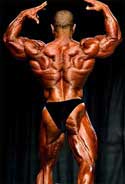
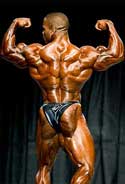
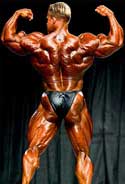



Mr. Olympia 2005 Results:
Sunday, October 16, 2005
- Ronnie Coleman
- Jay Cutler
- Gustavo Badell
- Gunter Schlierkamp
- Victor Martinez
- Dennis James
- Melvin Anthony
- Branch Warren
- Darrem Charles
- Mustafa Mohammed
- Johnnie Jackson
- George Farah
- Chris Cormier
- David Henry
- Markus Ruhl
(*)Top six qualify for 2006 Mr. Olympia
Did not make top 15
Kris Dim
Alexander Fedorov
Craig Richardson
Ronny Rockell
Mike Sheridan
Quincy Taylor
A New Mr Olympia ?
Check out the Results in future posts. But In my humble opinion Jay Cutler has a great chance to be the new Mr. Olympia 2005. Look at the photos.
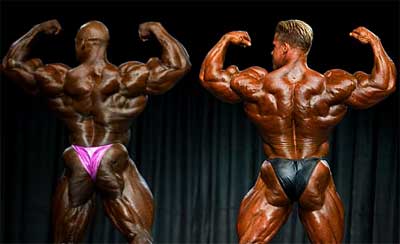
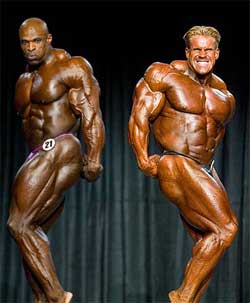
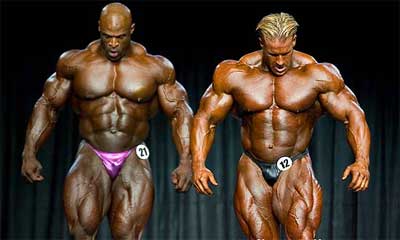
I am not alone thinking about Jay Cutler has a clear chance to win Mr. Olympia this year. Read the following comment written by: Greg Merritt, Flex Magazine Senior Writer
"Once again the Mr. Olympia title comes down to a two man race between Ronnie Coleman and Jay Cutler. This year, however, things could be different than the other three times the dueling duo finished one-two. As witnessed at the Saturday morning prejudging, King Coleman came in smaller than the last two years at 275, and his waist is notably slimmer with deeper abs. Meanwhile, Cutler is in his best condition ever at 264. Coleman still has detailed thickness Cutler doesn't possess in areas like chest and hamstrings, but Cutler hung with Mr. O in the compulsory poses and seemed to gain ground throughout the morning. In fact, when they called the duo out for the final comparison and as the raucous crowd screamed for one or the other, Cutler looked slightly better than Coleman in the two back poses (back double bi and rear lat spread), which were previously the champ's "Lights Out" shots. Whatever the scores say, this is not a "Lights Out" battle. The two physiques are very close, and coming into the night show, there is no telling which way the contest may swing. One thing is certain: History will be made at Saturday evening's show. Either Coleman will tie Lee Haney's record of eight Mr. O's or the heir apparent will end the king's run at seven and a new king of bodybuilding will be crowned."



I am not alone thinking about Jay Cutler has a clear chance to win Mr. Olympia this year. Read the following comment written by: Greg Merritt, Flex Magazine Senior Writer
"Once again the Mr. Olympia title comes down to a two man race between Ronnie Coleman and Jay Cutler. This year, however, things could be different than the other three times the dueling duo finished one-two. As witnessed at the Saturday morning prejudging, King Coleman came in smaller than the last two years at 275, and his waist is notably slimmer with deeper abs. Meanwhile, Cutler is in his best condition ever at 264. Coleman still has detailed thickness Cutler doesn't possess in areas like chest and hamstrings, but Cutler hung with Mr. O in the compulsory poses and seemed to gain ground throughout the morning. In fact, when they called the duo out for the final comparison and as the raucous crowd screamed for one or the other, Cutler looked slightly better than Coleman in the two back poses (back double bi and rear lat spread), which were previously the champ's "Lights Out" shots. Whatever the scores say, this is not a "Lights Out" battle. The two physiques are very close, and coming into the night show, there is no telling which way the contest may swing. One thing is certain: History will be made at Saturday evening's show. Either Coleman will tie Lee Haney's record of eight Mr. O's or the heir apparent will end the king's run at seven and a new king of bodybuilding will be crowned."
Mr. Olympia 2005 "WildCard" Results
- David Henry
- Brian Chamberlain
- Eddie Abbew
- Franklin Roberson
- Rusty Jeffers
- Armin Scholz
- Luke Wood
- Greg Rando
- Mike Morris
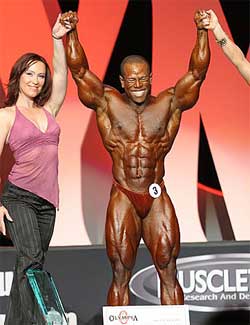
False Doping Tests Positives or Just Lies ?
Saturday, October 15, 2005
Case 1: Nandolone Decanoate
Recently, several prominent athletes tested positive for nandrolone decanoate (Deca Durabolin) – a powerful anabolic steroid that’s used to build muscle, lose fat and increase strength. When the test results were released, these athletes denied “knowingly” using steroids, and claimed that they took contaminated American-made dietary supplements.
While media outlets and ignorant and irresponsible reporters were touting contaminated dietary supplements as being responsible for these positive drug test outcomes, it was immediately clear to those with even a basic knowledge of anabolic steroids that these claims were impossible.
This was clear because not only are strict manufacturing controls used to make American dietary supplements, but nandrolone decanoate in an injected steroid – meaning that the athletes who self-administered this drug did so via a syringe. Nandrolone is not manufactured in an oral pill, and it can not, therefore, be present in dry powdered dietary supplements.
Case 2: BALCO
This now brings us to the athletes in the BALCO scandal. Were they victims of contaminated dietary supplements?
As already detailed, BALCO supplied elite athletes like Barry Bonds, Jason Giambii, Tim Montgomery, Marion Jones, Chryste Gaines and Michelle Collins with what it called “dietary supplements.” One of these “supplements” was a topical product known as “The Clear.” In testimony, some of these athletes denied “intentionally” using steroids, and pleaded innocent by claiming that they believed it to be the dietary supplement flax seed oil.
Do these claims withstand the test of objective scrutiny?
Once again, while media outlets and ignorant and irresponsible reporters were touting contaminated dietary supplements as being responsible for the BALCO scandal, it was immediately clear to those with even a basic knowledge of legitimate dietary supplements that it’s impossible to mistake any anabolic steroid drug for flax seed oil.
This was clear because while flax seed oil is a lipid, and while lipids are used to deliver anabolic steroids to the cells nucleus via passive permeation when ingested, flax seed oil in no way resembles any anabolic steroid drug - not even the various injected testosterones that are usually mixed with water or sesame oil. Additionally, flax seed oil has a foul odor, a foul taste, and it’s never rubbed on the skin for transdermal absorption; flax seed oil is always ingested orally, alone or with food.
Transdermal steroid creams, however, are well known, are sometimes used to treat legitimate medical conditions, are widely available on the black market, and are frequently used by athletes who want to use anabolic steroids without having to swallow pills (possibly causing liver damage) or having to use needles (possibly causing stinging welts and possible muscle abscesses that must be surgically removed).
Sadly, and as expected, the “flax seed oil” or “The Clear” supplied by BALCO to Barry Bonds and others, contained anabolic steroid drugs that were delivered transdermally.
Finally, we come to the case of baseball superstar Rafael Palmeiro.
Case 3: The Shocker – Rafael Palmeiro
Though the details of his drug test have not been disclosed by Major League Baseball, Mr. Palmeiro is believed to have tested positive for the steroid stanozolol. Like those before him, Mr. Palmeiro has pleaded innocent in the public arena, and has implied – but has not directly stated - that a contaminated dietary supplement was to blame for his positive drug test outcome.
Again, does this claim withstand the test of objective scrutiny?
The anabolic steroid stanozolol – sold under the trade name Winstrol – is injected (Winstrol Depot) or taken orally in tablet form. Medically, it is used to treat recurring conditions like genital swelling, and swelling of the face, hands, legs, and throat. As a performance enhancing drug, it is popular with athletes that play sports like track and field and baseball, where speed and strength are required to play the game successfully.
If you’ll recall, Canadian sprinter Ben Johnson became the fastest man in the world at the 1988 Olympics when he ran the 100 meters in 9.79 seconds. Subsequent to the race, he tested positive for stanozolol and was stripped of his record and his medals. Additionally, other world-class track athletes such as Carl Lewis, Linford Christie and Dennis Mitchell all tested positive for banned drugs during competitions.
Although Ben Johnson’s 9.79 second 100 meter world record was removed from the record books, it was never defeated until September 14, 2002 when the now disgraced BALCO scandal athlete Tim Montgomery ran the 100 meters in 9.78 seconds. Montgomery testified in the BALCO case that he obtained steroids and human growth hormone for competitions.
Winstrol is a popular drug among athletes in sports like track and field and baseball because it not only improves body composition by building muscle and burning fat, but it also enhances mood, sex drive, and athletic skill. An additional benefit of Winstrol is that it does not convert into estrogen in the body, and is free of many of the side-effects that accompany the use of other anabolic agents.
Winstrol exerts its effects on body composition, libido and athletic performance by limiting the action of Sex Hormone-Binding Globulin (SHBG). SHBG is a glycoprotein that binds to testosterone and prevents it from exerting its effects. By reducing the effects of SHBG, Winstrol causes fat loss, muscle gain, increased libido, and enhances athletic performance.
As a pharmaceutical drug belonging to the steroid class of drugs, Winstrol is legally available by prescription only for the treatment of legitimate medical disorders; Winstrol is not sold as an over-the-counter medication, and it is not a permitted dietary supplement ingredient (nor has it ever been found in any dietary supplement). These facts make the probability of testing positive for Winstrol after using a dietary supplement virtually zero.
Unfortunately - and because these facts are less sensational than positive drug test outcomes - these facts have received little media attention, and the Congress and the public continually believe that dietary supplements are contaminated and are responsible for the positive drug tests that are occurring in professional sports.
So far, however, it’s clear from the evidence presented that athlete claims about banned performance enhancing drugs and dietary supplement fail to withstand the test of objective scrutiny. Simply: their claims are weak, they do not withstand the facts, and they fail to convince.
We are, therefore, forced to ask: If American dietary supplements are not to blame for the positive drug test outcomes in professional sports, what is to blame? How is it that illegal drugs can enter an athlete’s body?
Possible Explanations for Doping Violations
Having established that American dietary supplements are of sufficient quality to make contamination highly unlikely, there are many potential and more probable ways that banned performance enhancing drugs can end up in an athlete’s body.
These ways are:
1. By eating contaminated foods
2. Drinking contaminated water
3. During the course of treatment for a medical condition
4. By intentional banned drug use
1. Contaminated Foods…
Eating contaminated foods represents a threat to athletes, and this is especially true in the case of meat products.
Dairy cattle, chickens and pigs are routinely injected with anabolic steroid drugs to increase lean muscle mass, reduce body fat, and increase their market value. Unfortunately, many of these drugs survive the cooking process, and if the athlete eats contaminated meat in sufficient amounts, steroidal metabolites may show up on drug tests.
Although this testing outcome is hypothetically possible, and is believed to have occurred in several isolated cases, it could not be conclusively established in these cases if the detected anabolic steroid metabolites were present prior to feeding as no tests were conducted prior to this time. It’s believed by experts, therefore, that the chances of getting a positive drug test outcome from eating meat, or any other food, is very low.
2. Contaminated Water…
Drinking contaminated water from ground or municipal water supplies represents a threat to athletes, but this threat is one posed to the immune system function and general health.
It is estimated that eighty percent of all wells in America are contaminated with e-coli and other pathogens and pollutants. What’s worse, many municipal water supplies are contaminated with prescription pharmaceuticals like antibiotics, birth control pills, anabolic steroids, blood pressure medications, and other drugs. These drugs find their way into water supplies when they are dumped in the garbage, or flushed down the toilet.
Unfortunately, water treatment methods are largely ineffective for eliminating these contaminants because many water treatment programs have been scaled back as a result of budget cutbacks.
That being said, and although drugs are present in drinking water, these drugs are sufficiently diluted to make the probability of eliciting a positive drug test outcome almost zero.
3. Treatment for A Medical Condition…
The third way that potentially banned drugs can enter into an athletes body is as part of a treatment program for a legitimate medical condition. Athletes with ADHD (Attention Deficit Hyperactivity Disorder), for example, frequently use Ritalin (Methylphenidate) to treat attention problems that can interfere with the mental focus needed for competition. Also, athletes with wasting diseases like MS, or HIV or AIDS may use anabolic steroids to preserve lean muscle tissue and boost immune system function.
Finally, older athletes may be placed on anabolic steroids as part of a hormone replacement therapy program, designed to offset the physical, sexual, emotional and mental effects of declining hormone levels.
When being treated for a medical condition, athletes in drug-regulated sports must disclose their use of these medications prior to competition, supply the necessary medical documentation substantiating the legitimate use of these drugs, and obtain from their sporting federations or regulatory bodies the clearance to compete. If the supplied documentation is sufficient to satisfy the regulatory requirements, athletes are cleared for competition.
4. Intentional Drug Use…
The fourth and final way that banned drugs can find their way into an athlete’s body is if the athlete uses them intentionally to enhance performance.
Since the dawn of competitive sport, athletes world-wide have used anabolic steroids and other drugs to modify body composition and enhance performance. With the dawn of modern testing methods and anti-doping programs aimed at preventing such abuses, athletes and the chemists who supply them with these drugs have aimed to circumvent anti-doping procedures by developing drugs to mask the presence of banned performance enhancers.
The subcommittee hearing on Medical Devices and Drug Issues on April 8 and May 4, 1987 demonstrated how rampant drug use has become in modern sport, why drug use is rampant in organized professional sport, and the level of determination that drives athletes to seek any edge to increase chances of victory.
Here is a transcript on those hearings that clearly explain this situation:
Mr. Coats: Dr. Voy, you testified that the consequences or possible side effects [of anabolic steroid use] are decreased muscle capacity, decreased athletic ability. Obviously, this is not believed by the athletes or not experienced by the athletes or they wouldn't keep taking this stuff.
Mr. Voy: ... if athletes thought you could capsulate horse manure, pardon the expression, in a capsule and take it three times a day, athletes would take it that. I am not saying that critical of athletes. I'm simply stating the necessity athletes find themselves in, when they dedicate years and years of their life, their family and everything else to their sport and realize to win, they have to use performance enhancing substances. It is an unfair predicament. They will do it no matter what we attempt to do. That is one of the reasons why cheating is one of the main objects of the Olympic Committee's drug testing program, to attempt to assure the American public and our sports organizations of fair competition."
Mr. Todd: I would have a bought a horse, for example.
These excerpts show clearly that performance enhancing drugs are a permanent part of organized sports, and that athletes must use these drugs if they want to compete and make a living playing professional sports.
Because of these extreme pressures, and because the competitive playing field is seldom even, athletes are forced go to drastic lengths to obtain and use banned drugs. Not only do they purchase drugs from black market sources (or hire someone to purchase them), they also employ almost every measure imaginable to avoid complying with doping regulations.
If and when they are tested, many athletes do whatever they can to hide evidence of banned drug use – sometimes they swap dirty urine samples for clean urine samples, sometimes they steal other peoples urine samples, or they take drugs - “masking agents” – that are specifically designed to defeat drug tests by hiding the presence of banned drug metabolites that the tests are designed to detect and measure.
If and when these compliance avoidance measures fail, and if and when drug using athletes are caught, the standard practice is to either apologize outright and to have “no further comment”, or to plead ignorance, to claim that they have never “intentionally” used banned drugs, and to blame benign dietary supplements.
Despite the many denials, the facts show the truth: the majority of these athletes intentionally cheat, and they lie to avoid taking responsibility.
Things to Come: Rafaeil Palmeiro and the Final Verdict...
In the first two parts of Talking Straight About Steroids & Supplements, I’ve given you the information that you need to understand:
1. The past and current scandals involving anabolic steroids and dietary supplements use in sports.
2. What dietary supplements ARE and ARE NOT.
3. How your dietary supplements are made and handled from raw product extraction to the point of sale.
4. Why athlete claims about contaminated dietary supplements are just one big lie.
5. The possible ways by which banned drugs can enter into an athlete’s body.
In third and final part of this series, I’m going talk about and examine the highest profile doping violation to date: the positive drug test of baseball superstar Mr. Rafael Palmeiro. Was Mr. Palmeiro the victim of a contaminated supplement, or is there another reason for his positive test outcome?
Recently, several prominent athletes tested positive for nandrolone decanoate (Deca Durabolin) – a powerful anabolic steroid that’s used to build muscle, lose fat and increase strength. When the test results were released, these athletes denied “knowingly” using steroids, and claimed that they took contaminated American-made dietary supplements.
While media outlets and ignorant and irresponsible reporters were touting contaminated dietary supplements as being responsible for these positive drug test outcomes, it was immediately clear to those with even a basic knowledge of anabolic steroids that these claims were impossible.
This was clear because not only are strict manufacturing controls used to make American dietary supplements, but nandrolone decanoate in an injected steroid – meaning that the athletes who self-administered this drug did so via a syringe. Nandrolone is not manufactured in an oral pill, and it can not, therefore, be present in dry powdered dietary supplements.
Case 2: BALCO
This now brings us to the athletes in the BALCO scandal. Were they victims of contaminated dietary supplements?
As already detailed, BALCO supplied elite athletes like Barry Bonds, Jason Giambii, Tim Montgomery, Marion Jones, Chryste Gaines and Michelle Collins with what it called “dietary supplements.” One of these “supplements” was a topical product known as “The Clear.” In testimony, some of these athletes denied “intentionally” using steroids, and pleaded innocent by claiming that they believed it to be the dietary supplement flax seed oil.
Do these claims withstand the test of objective scrutiny?
Once again, while media outlets and ignorant and irresponsible reporters were touting contaminated dietary supplements as being responsible for the BALCO scandal, it was immediately clear to those with even a basic knowledge of legitimate dietary supplements that it’s impossible to mistake any anabolic steroid drug for flax seed oil.
This was clear because while flax seed oil is a lipid, and while lipids are used to deliver anabolic steroids to the cells nucleus via passive permeation when ingested, flax seed oil in no way resembles any anabolic steroid drug - not even the various injected testosterones that are usually mixed with water or sesame oil. Additionally, flax seed oil has a foul odor, a foul taste, and it’s never rubbed on the skin for transdermal absorption; flax seed oil is always ingested orally, alone or with food.
Transdermal steroid creams, however, are well known, are sometimes used to treat legitimate medical conditions, are widely available on the black market, and are frequently used by athletes who want to use anabolic steroids without having to swallow pills (possibly causing liver damage) or having to use needles (possibly causing stinging welts and possible muscle abscesses that must be surgically removed).
Sadly, and as expected, the “flax seed oil” or “The Clear” supplied by BALCO to Barry Bonds and others, contained anabolic steroid drugs that were delivered transdermally.
Finally, we come to the case of baseball superstar Rafael Palmeiro.
Case 3: The Shocker – Rafael Palmeiro
Though the details of his drug test have not been disclosed by Major League Baseball, Mr. Palmeiro is believed to have tested positive for the steroid stanozolol. Like those before him, Mr. Palmeiro has pleaded innocent in the public arena, and has implied – but has not directly stated - that a contaminated dietary supplement was to blame for his positive drug test outcome.
Again, does this claim withstand the test of objective scrutiny?
The anabolic steroid stanozolol – sold under the trade name Winstrol – is injected (Winstrol Depot) or taken orally in tablet form. Medically, it is used to treat recurring conditions like genital swelling, and swelling of the face, hands, legs, and throat. As a performance enhancing drug, it is popular with athletes that play sports like track and field and baseball, where speed and strength are required to play the game successfully.
If you’ll recall, Canadian sprinter Ben Johnson became the fastest man in the world at the 1988 Olympics when he ran the 100 meters in 9.79 seconds. Subsequent to the race, he tested positive for stanozolol and was stripped of his record and his medals. Additionally, other world-class track athletes such as Carl Lewis, Linford Christie and Dennis Mitchell all tested positive for banned drugs during competitions.
Although Ben Johnson’s 9.79 second 100 meter world record was removed from the record books, it was never defeated until September 14, 2002 when the now disgraced BALCO scandal athlete Tim Montgomery ran the 100 meters in 9.78 seconds. Montgomery testified in the BALCO case that he obtained steroids and human growth hormone for competitions.
Winstrol is a popular drug among athletes in sports like track and field and baseball because it not only improves body composition by building muscle and burning fat, but it also enhances mood, sex drive, and athletic skill. An additional benefit of Winstrol is that it does not convert into estrogen in the body, and is free of many of the side-effects that accompany the use of other anabolic agents.
Winstrol exerts its effects on body composition, libido and athletic performance by limiting the action of Sex Hormone-Binding Globulin (SHBG). SHBG is a glycoprotein that binds to testosterone and prevents it from exerting its effects. By reducing the effects of SHBG, Winstrol causes fat loss, muscle gain, increased libido, and enhances athletic performance.
As a pharmaceutical drug belonging to the steroid class of drugs, Winstrol is legally available by prescription only for the treatment of legitimate medical disorders; Winstrol is not sold as an over-the-counter medication, and it is not a permitted dietary supplement ingredient (nor has it ever been found in any dietary supplement). These facts make the probability of testing positive for Winstrol after using a dietary supplement virtually zero.
Unfortunately - and because these facts are less sensational than positive drug test outcomes - these facts have received little media attention, and the Congress and the public continually believe that dietary supplements are contaminated and are responsible for the positive drug tests that are occurring in professional sports.
So far, however, it’s clear from the evidence presented that athlete claims about banned performance enhancing drugs and dietary supplement fail to withstand the test of objective scrutiny. Simply: their claims are weak, they do not withstand the facts, and they fail to convince.
We are, therefore, forced to ask: If American dietary supplements are not to blame for the positive drug test outcomes in professional sports, what is to blame? How is it that illegal drugs can enter an athlete’s body?
Possible Explanations for Doping Violations
Having established that American dietary supplements are of sufficient quality to make contamination highly unlikely, there are many potential and more probable ways that banned performance enhancing drugs can end up in an athlete’s body.
These ways are:
1. By eating contaminated foods
2. Drinking contaminated water
3. During the course of treatment for a medical condition
4. By intentional banned drug use
1. Contaminated Foods…
Eating contaminated foods represents a threat to athletes, and this is especially true in the case of meat products.
Dairy cattle, chickens and pigs are routinely injected with anabolic steroid drugs to increase lean muscle mass, reduce body fat, and increase their market value. Unfortunately, many of these drugs survive the cooking process, and if the athlete eats contaminated meat in sufficient amounts, steroidal metabolites may show up on drug tests.
Although this testing outcome is hypothetically possible, and is believed to have occurred in several isolated cases, it could not be conclusively established in these cases if the detected anabolic steroid metabolites were present prior to feeding as no tests were conducted prior to this time. It’s believed by experts, therefore, that the chances of getting a positive drug test outcome from eating meat, or any other food, is very low.
2. Contaminated Water…
Drinking contaminated water from ground or municipal water supplies represents a threat to athletes, but this threat is one posed to the immune system function and general health.
It is estimated that eighty percent of all wells in America are contaminated with e-coli and other pathogens and pollutants. What’s worse, many municipal water supplies are contaminated with prescription pharmaceuticals like antibiotics, birth control pills, anabolic steroids, blood pressure medications, and other drugs. These drugs find their way into water supplies when they are dumped in the garbage, or flushed down the toilet.
Unfortunately, water treatment methods are largely ineffective for eliminating these contaminants because many water treatment programs have been scaled back as a result of budget cutbacks.
That being said, and although drugs are present in drinking water, these drugs are sufficiently diluted to make the probability of eliciting a positive drug test outcome almost zero.
3. Treatment for A Medical Condition…
The third way that potentially banned drugs can enter into an athletes body is as part of a treatment program for a legitimate medical condition. Athletes with ADHD (Attention Deficit Hyperactivity Disorder), for example, frequently use Ritalin (Methylphenidate) to treat attention problems that can interfere with the mental focus needed for competition. Also, athletes with wasting diseases like MS, or HIV or AIDS may use anabolic steroids to preserve lean muscle tissue and boost immune system function.
Finally, older athletes may be placed on anabolic steroids as part of a hormone replacement therapy program, designed to offset the physical, sexual, emotional and mental effects of declining hormone levels.
When being treated for a medical condition, athletes in drug-regulated sports must disclose their use of these medications prior to competition, supply the necessary medical documentation substantiating the legitimate use of these drugs, and obtain from their sporting federations or regulatory bodies the clearance to compete. If the supplied documentation is sufficient to satisfy the regulatory requirements, athletes are cleared for competition.
4. Intentional Drug Use…
The fourth and final way that banned drugs can find their way into an athlete’s body is if the athlete uses them intentionally to enhance performance.
Since the dawn of competitive sport, athletes world-wide have used anabolic steroids and other drugs to modify body composition and enhance performance. With the dawn of modern testing methods and anti-doping programs aimed at preventing such abuses, athletes and the chemists who supply them with these drugs have aimed to circumvent anti-doping procedures by developing drugs to mask the presence of banned performance enhancers.
The subcommittee hearing on Medical Devices and Drug Issues on April 8 and May 4, 1987 demonstrated how rampant drug use has become in modern sport, why drug use is rampant in organized professional sport, and the level of determination that drives athletes to seek any edge to increase chances of victory.
Here is a transcript on those hearings that clearly explain this situation:
Mr. Coats: Dr. Voy, you testified that the consequences or possible side effects [of anabolic steroid use] are decreased muscle capacity, decreased athletic ability. Obviously, this is not believed by the athletes or not experienced by the athletes or they wouldn't keep taking this stuff.
Mr. Voy: ... if athletes thought you could capsulate horse manure, pardon the expression, in a capsule and take it three times a day, athletes would take it that. I am not saying that critical of athletes. I'm simply stating the necessity athletes find themselves in, when they dedicate years and years of their life, their family and everything else to their sport and realize to win, they have to use performance enhancing substances. It is an unfair predicament. They will do it no matter what we attempt to do. That is one of the reasons why cheating is one of the main objects of the Olympic Committee's drug testing program, to attempt to assure the American public and our sports organizations of fair competition."
Mr. Todd: I would have a bought a horse, for example.
These excerpts show clearly that performance enhancing drugs are a permanent part of organized sports, and that athletes must use these drugs if they want to compete and make a living playing professional sports.
Because of these extreme pressures, and because the competitive playing field is seldom even, athletes are forced go to drastic lengths to obtain and use banned drugs. Not only do they purchase drugs from black market sources (or hire someone to purchase them), they also employ almost every measure imaginable to avoid complying with doping regulations.
If and when they are tested, many athletes do whatever they can to hide evidence of banned drug use – sometimes they swap dirty urine samples for clean urine samples, sometimes they steal other peoples urine samples, or they take drugs - “masking agents” – that are specifically designed to defeat drug tests by hiding the presence of banned drug metabolites that the tests are designed to detect and measure.
If and when these compliance avoidance measures fail, and if and when drug using athletes are caught, the standard practice is to either apologize outright and to have “no further comment”, or to plead ignorance, to claim that they have never “intentionally” used banned drugs, and to blame benign dietary supplements.
Despite the many denials, the facts show the truth: the majority of these athletes intentionally cheat, and they lie to avoid taking responsibility.
Things to Come: Rafaeil Palmeiro and the Final Verdict...
In the first two parts of Talking Straight About Steroids & Supplements, I’ve given you the information that you need to understand:
1. The past and current scandals involving anabolic steroids and dietary supplements use in sports.
2. What dietary supplements ARE and ARE NOT.
3. How your dietary supplements are made and handled from raw product extraction to the point of sale.
4. Why athlete claims about contaminated dietary supplements are just one big lie.
5. The possible ways by which banned drugs can enter into an athlete’s body.
In third and final part of this series, I’m going talk about and examine the highest profile doping violation to date: the positive drug test of baseball superstar Mr. Rafael Palmeiro. Was Mr. Palmeiro the victim of a contaminated supplement, or is there another reason for his positive test outcome?
Marcos Chacon New IFBB Pro ?
Thursday, October 06, 2005
Marcos Chacon is a well known spanish bodybuilder. After some years resting from contests and competitions, he is ready to win the overall national bodybuilding title of Spain. I enclose some photos 2 weeks 2 weeks out the contest. He looks really IMPRESIVE! I will keep you informed about the results of this competition. But be ready for this probably new IFBB Pro.
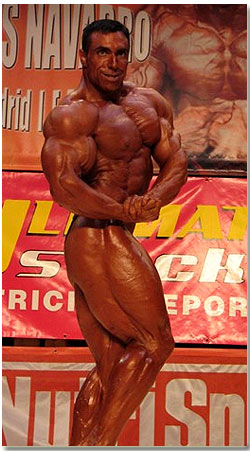
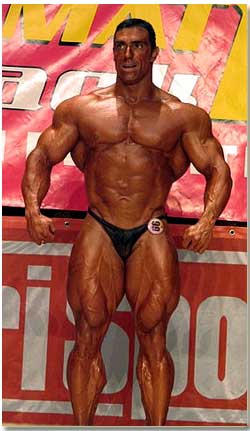


Charlotte Professional Bodybuilding Contest 2005
Wednesday, October 05, 2005
- Branch Warren
- Dennis James
- George Farah
- Mustafa Mohammad
- Quincy Taylor
- Craig Richardson
- Brian Chamberlain
- Fakhri Mubarak
- Miguel Oliveira
- Milton Holloway
- Armin Scholz
- Rusty Jeffers
- Johnny Stewart
- Greg Rando
- Scott Milne
Talking Straight on Steroids & Supplements (1)
Saturday, October 01, 2005
by Clayton South
If you're like me, you've spent the last couple of months following the news on steroids in sports with the hope that some truth - any truth - would emerge from the midst of the media hype and sensationalism.
While the issue of steroids in sport has been brewing since the early 1980's, and while the Congressional Hearings in 1987 on Medical Devices and Drug Issues on April 8 and May 4, 1987 sought to address the issue of drugs in sport, nothing of substance followed from these hearings and steroids are today as much a part of organized sports as they've always been.
The Current Scandals . . .
The current sensationalism on steroids in sport began with two major events:
1. The publication of Jose Canseco's book "Juiced: Wild Times, Rampant 'Roids, Smash Hits, and How Baseball Got Big."
2. The now infamous BALCO scandal.
In his book, Mr. Canseco names several high-profile players that he claims to have injected with anabolic steroids. Some of these players include superstars like Mark McGwire, Ivan Rodriguez, Sammy Sosa, and Rafael Palmeiro.
As a result of his book, Congress again held hearings on the role of performance enhancing drugs in sport. During these hearings, Mark McGwire, Sammy Sosa and Rafael Palmeiro testified under oath on the role of steroids in sports. While Mark McGwire dodged the question of whether he used anabolic steroid by stating "I'm not here to discuss the past…I'm a retired player", Sammy Sosa [through an interpreter] and Rafael Palmeiro strongly denied ever having used anabolic steroids.
While the other players present also denied using steroids, Mr. Palmeiro issued a strong denial when he remarked: "I have never used steroids. Period. I don't know how to say it any more clearly than that. Never. The reference to me in Mr. Canseco's book is absolutely false. I am against the use of steroids." As the Congressional Hearings were proceeding, the BALCO case was slowly working its' way through the legal system.
BALCO (Bay Area Lab Co-Operative) was a company run by Victor Conte, and it was responsible for supplying "dietary supplements" to high profile athletes like baseball superstars Barry Bonds and Jason Giambii, and Olympic athletes Marion Jones, Tim Montgomery, Chryste Gaines and Michelle Collins.
Since the completion of the BALCO investigation and the start of the legal prosecution of Victor Conte, it's been revealed that many of the "dietary supplements" given to athletes under the names of legitimate dietary supplements were really banned anabolic compounds.
These banned drugs included:
While BALCO did supply athletes with legitimate dietary supplements like Vitamins E, B-12, Iron, Ferulic acid, ZMA and Tyrosine, the above list of banned substances are powerful and potentially dangerous pharmaceutical drugs that in no way resemble safe and effective over-the-counter dietary supplements.
Subsequent to the current Congressional hearings on the role of drugs in sport, several high-profile baseball athletes have tested positive for performance enhancing drugs.
New York Yankees slugger Jason Giambii is among these athletes, and he admitted in leaked Grand Jury testimony to having knowingly used anabolic steroids and Human Growth Hormone for at least three seasons. Shockingly, one other man tested positive for anabolic steroid use - the man who issued the strongest denial and condemnation of anabolic steroids: baseball superstar Rafael Palmeiro.
Like the many athletes before him who have tested positive for banned performance enhancing drugs, Mr. Palmeiro denies knowing how the drugs entered his body. Instead, he's made the standard claim that's been made by countless others who have been busted for banned drug use: he claims that he was the victim of contaminated dietary supplements.
It's been said that "The great masses of the people... will more easily fall victims to a big lie than to a small one" and "…nearly any invented quotation, played with confidence, stands a good chance to deceive." Commenting on this, Mark Twain commented:
"…people's beliefs and convictions are in almost every case gotten at second-hand, and without examination, from authorities who have not themselves examined the questions at issue but have taken them at second-hand from other non-examiners, whose opinions about them were not worth a brass farthing."
If you're like me, you've spent the last couple of months following the news on steroids in sports with the hope that some truth - any truth - would emerge from the midst of the media hype and sensationalism.
While the issue of steroids in sport has been brewing since the early 1980's, and while the Congressional Hearings in 1987 on Medical Devices and Drug Issues on April 8 and May 4, 1987 sought to address the issue of drugs in sport, nothing of substance followed from these hearings and steroids are today as much a part of organized sports as they've always been.
The Current Scandals . . .
The current sensationalism on steroids in sport began with two major events:
1. The publication of Jose Canseco's book "Juiced: Wild Times, Rampant 'Roids, Smash Hits, and How Baseball Got Big."
2. The now infamous BALCO scandal.
In his book, Mr. Canseco names several high-profile players that he claims to have injected with anabolic steroids. Some of these players include superstars like Mark McGwire, Ivan Rodriguez, Sammy Sosa, and Rafael Palmeiro.
As a result of his book, Congress again held hearings on the role of performance enhancing drugs in sport. During these hearings, Mark McGwire, Sammy Sosa and Rafael Palmeiro testified under oath on the role of steroids in sports. While Mark McGwire dodged the question of whether he used anabolic steroid by stating "I'm not here to discuss the past…I'm a retired player", Sammy Sosa [through an interpreter] and Rafael Palmeiro strongly denied ever having used anabolic steroids.
While the other players present also denied using steroids, Mr. Palmeiro issued a strong denial when he remarked: "I have never used steroids. Period. I don't know how to say it any more clearly than that. Never. The reference to me in Mr. Canseco's book is absolutely false. I am against the use of steroids." As the Congressional Hearings were proceeding, the BALCO case was slowly working its' way through the legal system.
BALCO (Bay Area Lab Co-Operative) was a company run by Victor Conte, and it was responsible for supplying "dietary supplements" to high profile athletes like baseball superstars Barry Bonds and Jason Giambii, and Olympic athletes Marion Jones, Tim Montgomery, Chryste Gaines and Michelle Collins.
Since the completion of the BALCO investigation and the start of the legal prosecution of Victor Conte, it's been revealed that many of the "dietary supplements" given to athletes under the names of legitimate dietary supplements were really banned anabolic compounds.
These banned drugs included:
- Human Growth Hormone
- Erythropoietin
- I
- THG
- Testosterone
While BALCO did supply athletes with legitimate dietary supplements like Vitamins E, B-12, Iron, Ferulic acid, ZMA and Tyrosine, the above list of banned substances are powerful and potentially dangerous pharmaceutical drugs that in no way resemble safe and effective over-the-counter dietary supplements.
Subsequent to the current Congressional hearings on the role of drugs in sport, several high-profile baseball athletes have tested positive for performance enhancing drugs.
New York Yankees slugger Jason Giambii is among these athletes, and he admitted in leaked Grand Jury testimony to having knowingly used anabolic steroids and Human Growth Hormone for at least three seasons. Shockingly, one other man tested positive for anabolic steroid use - the man who issued the strongest denial and condemnation of anabolic steroids: baseball superstar Rafael Palmeiro.
Like the many athletes before him who have tested positive for banned performance enhancing drugs, Mr. Palmeiro denies knowing how the drugs entered his body. Instead, he's made the standard claim that's been made by countless others who have been busted for banned drug use: he claims that he was the victim of contaminated dietary supplements.
It's been said that "The great masses of the people... will more easily fall victims to a big lie than to a small one" and "…nearly any invented quotation, played with confidence, stands a good chance to deceive." Commenting on this, Mark Twain commented:
"…people's beliefs and convictions are in almost every case gotten at second-hand, and without examination, from authorities who have not themselves examined the questions at issue but have taken them at second-hand from other non-examiners, whose opinions about them were not worth a brass farthing."